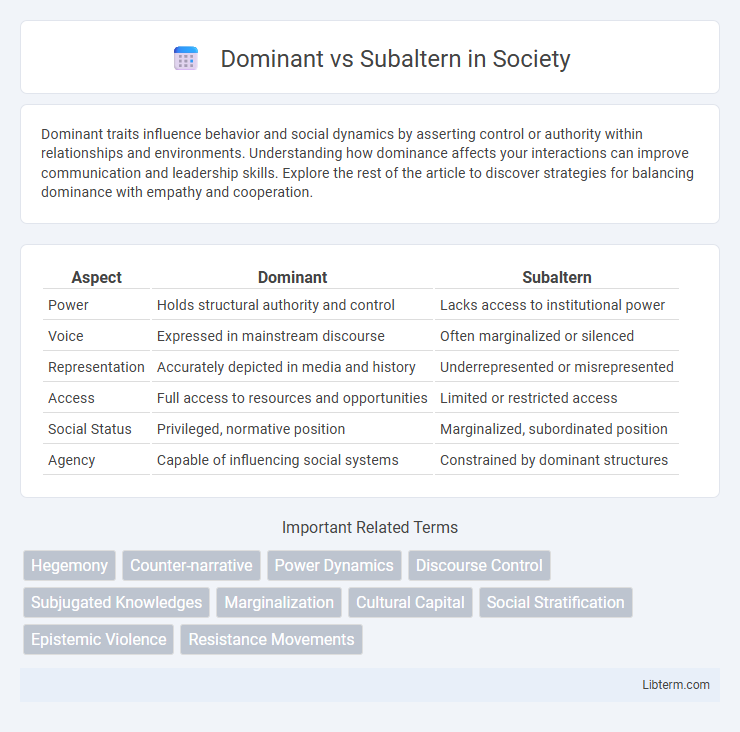Dominant traits influence behavior and social dynamics by asserting control or authority within relationships and environments. Understanding how dominance affects your interactions can improve communication and leadership skills. Explore the rest of the article to discover strategies for balancing dominance with empathy and cooperation.
Table of Comparison
| Aspect | Dominant | Subaltern |
|---|---|---|
| Power | Holds structural authority and control | Lacks access to institutional power |
| Voice | Expressed in mainstream discourse | Often marginalized or silenced |
| Representation | Accurately depicted in media and history | Underrepresented or misrepresented |
| Access | Full access to resources and opportunities | Limited or restricted access |
| Social Status | Privileged, normative position | Marginalized, subordinated position |
| Agency | Capable of influencing social systems | Constrained by dominant structures |
Understanding Dominant and Subaltern: Key Definitions
Dominant refers to the social groups or cultures that hold power, influence, and control over resources, often shaping societal norms and values. Subaltern describes marginalized or oppressed groups excluded from dominant power structures and lacking representation in mainstream discourse. Understanding these key definitions is essential for analyzing power dynamics, social hierarchies, and resistance within cultural and political contexts.
Historical Context of Dominant and Subaltern Groups
Dominant groups have historically wielded political, economic, and cultural power, shaping societal norms and institutional structures to maintain control and privilege. Subaltern groups, often marginalized along lines of race, class, ethnicity, or colonial status, experienced systemic exclusion and resistance within these power hierarchies. The historical context of colonialism, slavery, and imperialism critically informs the dynamics between dominant and subaltern groups, highlighting patterns of oppression and subjugation that persist in contemporary social relations.
Power Dynamics: How Dominance is Established
Dominance is established through control of resources, cultural narratives, and institutional authority, reinforcing the power of the dominant group over the subaltern. Mechanisms such as language imposition, legal systems, and media representation systematically marginalize subaltern voices, entrenching social hierarchies. Power dynamics are maintained by legitimizing dominant ideologies and suppressing alternative perspectives to sustain hegemony.
Voices of the Subaltern: Silenced Narratives
Subaltern voices represent marginalized groups whose perspectives and experiences are often excluded from dominant historical and cultural narratives, leading to a pervasive silence that obscures their agency and identity. Postcolonial theorists like Gayatri Chakravorty Spivak argue that subalterns lack representation within hegemonic discourse, making their true voices difficult to access or understand. Recovering these silenced narratives involves critical examination of power dynamics and the use of alternative methodologies to amplify subaltern experiences in academic and social contexts.
Representation in Media: Dominant vs Subaltern Perspectives
Representation in media often reflects dominant perspectives, shaping mainstream narratives that marginalize subaltern voices and experiences. Dominant groups control media production, leading to selective portrayals that reinforce power hierarchies and cultural hegemony. Subaltern perspectives, when included, challenge prevailing discourses by revealing alternative realities and contested identities.
Education Systems: Reproducing Dominance and Subalternity
Education systems often perpetuate existing social hierarchies by privileging dominant cultural norms and knowledge, marginalizing subaltern groups whose histories and perspectives remain underrepresented. Curriculum design, language of instruction, and access to resources reinforce dominant ideologies, limiting opportunities for subaltern communities to challenge systemic inequalities. This reproduction of dominance through education sustains cycles of social exclusion and entrenched power disparities.
Economic Inequality: The Role of Dominant Structures
Dominant structures perpetuate economic inequality by controlling access to resources, capital, and opportunities, reinforcing the power imbalance between dominant and subaltern groups. Economic policies and institutional frameworks often favor dominant elites, entrenching wealth concentration and limiting social mobility for marginalized populations. Addressing economic inequality requires dismantling systemic barriers embedded within dominant structures to create equitable economic participation.
Resistance and Agency Among Subaltern Groups
Subaltern groups exhibit resistance through diverse forms of agency, challenging dominant power structures by reclaiming cultural identity and asserting political voice. Their strategies include grassroots mobilization, symbolic protests, and creating alternative narratives that disrupt hegemonic discourses. These acts of resistance highlight the dynamic interaction between power and subjugation, emphasizing the subaltern's capacity to influence socio-political change despite systemic marginalization.
The Impact of Globalization on Dominant-Subaltern Relations
Globalization intensifies dominant-subaltern relations by amplifying the economic and cultural influence of powerful nations over marginalized communities, often resulting in unequal resource distribution and cultural homogenization. Multinational corporations and international institutions frequently reinforce dominant ideologies, limiting subaltern agency and perpetuating systemic inequalities across borders. Digital technologies and global media further complicate these dynamics by enabling subaltern voices to resist and negotiate their identities while simultaneously exposing them to dominant narratives.
Building Bridges: Towards Inclusive Social Structures
Building bridges between dominant and subaltern groups fosters inclusive social structures by promoting mutual recognition and equal participation. Integrating diverse voices challenges hierarchical power dynamics and encourages collaborative decision-making processes. Inclusive frameworks enhance social cohesion, addressing systemic inequalities through shared understanding and empowerment.
Dominant Infographic

 libterm.com
libterm.com